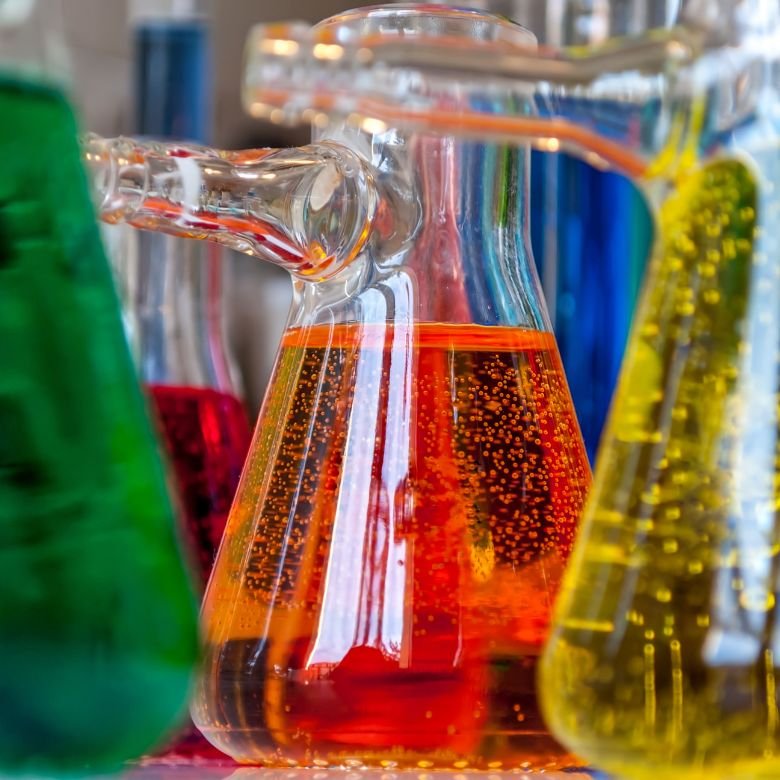Oxyacids are an extremely important group of chemical compounds that have a number o specific properties. They are characterised by the presence of at least one atom of oxygen in the acidic radical. They are an important raw material in many industrial processes. Oxyacids are used in the chemical, pharmaceutical, paper and other industries.

Structure and production of oxyacids
Oxyacids consist of three key elements: an atom of oxygen, an acid-forming element and at least one hydrogen atom bonded to oxygen. The central atom is usually a non-metal such as sulphur, nitrogen or phosphorus. These elements are called the “acid-forming elements”. These can also include certain metals at their higher oxidation states, such as manganese (VII). The names of oxyacids are created from the name of the acid-forming element, with its valency specified in brackets, and adding the suffix -ic, i.e. phosphoric acid, sulphuric acid, nitric acid, etc. If a specific element is present in several oxyacids, its valency must absolutely be specified in the name of the acid.
Oxyacids are mainly obtained through the reaction of acid anhydrides with water. Anhydrides are oxides of specific non-metals (or certain metals). Inthis case, oxyacids can be obtained in two stages. In the first stage, an acid-forming element is burned in oxygen. An example of such a reaction is the combustion of phosphorus (which forms four-atom molecules). Phosphorus (V) oxide, or phosphorus pentoxide, is formed in the form of white fumes. The resulting acid anhydride is then dissolved in water to form phosphoric acid. If methyl orange (a pH indicator) is added to the system, the solution will turn red, since the acid obtained has lowered the pH of the solution. Another way to obtain oxyacids is through (double) displacement reactions. When you act with a strong acid on a specific salt, you can displace a weaker acid from its salt.
Characteristics of oxyacids
Oxyacids are classified as so-called electrolytes, i.e. compounds that can conduct electric current. Depending on the acid, they can undergo electrolytic dissociation in water to a varied extent. In aqueous solutions, oxyacids dissociate into positive ions (cations) and negative ions (anions), which can carry an electric charge. Acids are classified into:
- strong acids, which dissociate completely into hydrogen cations and acidic radical anions. Strong oxyacids include sulphuric (VI) acid, nitric (V) acid, chloric (VII) acid.
- Weak oxyacids, which do not undergo complete electrolytic dissociation. In aqueous solutions, most of their molecules remain undissociated. Generally, acids based on elements of lower oxidation states have low strength; these include sulphuric (IV) or nitric (III) acid. Carbonic acid, H2CO3, is the weakest oxyacid. It is very unstable. It is often displaced from solutions by stronger acids.
The greater the electronegativity of the central atom forming the acidic radical of a given acid, the stronger the acid itself. If the same element forms several acids, its strength increases with the number of oxygen atoms in the molecule.
Moreover, the strength of an oxyacid can be determined by its ability to dissociate hydrogen ions (the degree of dissociation). Single-proton acids (that have one hydrogen cation) dissociate in a single step, while multi-proton acids (with more than one hydrogen atom in the molecule) dissociate in several steps. Each of them has a specific equilibrium equation. The first stage is always the fastest. Dissociated hydrogen atoms combine with water molecules to form oxonium ions (H3O+). They cause the acidic pH of aqueous acid solutions.
Oxyacids react with basic oxides and hydroxides. As a result of these reactions, corresponding salts and water are formed. Importantly, oxyacids do not react with acidic oxides. They react with chemically active metals (such as alkaline earth metals or alkali metals). These metals displace hydrogen from acid molecules to form salts. Noble metals (that are not very chemically active) do not react with oxyacids in a similar manner since they do not displace their hydrogen atoms. They only react with oxidising acids, i.e. a concentrated solution of sulphuric acid or nitric acid.

Properties and applications of selected oxyacids
It is a strong acid in the form of an oily liquid. At 1.84 g/cm3, its density is almost twice higher than that of water. It mixes with water in almost every ratio, releasing plenty of heat. Sulphuric acid is highly hygroscopic. A solution with the concentration of 98% of sulphuric acid is commercially available. Oleum is a solution of sulphur oxide, SO3, in sulphuric acid.
H2SO4 is a key by product in the industry. It is used for the production of fertilisers (e.g. superphosphate), other acids (e.g. formic acid), laundry detergents, explosives, pesticides, rubber, paper and other things.
Nitric acid is a colourless liquid that is easily soluble in water. Concentrated solutions (of about 68%) have strong oxidising properties. HNO3 causes characteristic yellowing of proteins (the xanthoproteic reaction). Concentrated nitric acid gives off fumes as a result of its decomposition with the release of brown nitric oxide.
The primary applications of nitric acid mainly include the preparation of other chemical substances (such as certain salts, esters or nitro compounds). An important demand for HNO3 comes from the ammonium nitrate production process. The acid is also used to make explosives, dyes, to clean metal surfaces and in the pharmaceutical industry.
An aqueous solution of this acid (an oily liquid) at a concentration of around 85% is most commonly used in laboratories. Pure H3PO4 is also available: it comes in the form of white crystals (at room temperature). Phosphoric acid is strongly hygroscopic. It forms three series of salts: phosphates (V), dihydrogen phosphates (V) and hydrogen phosphates (V).
Phosphoric acid is an important product in the industry. Significant amounts of it are consumed in chemical and pharmaceutical processes, such as in the manufacture of mineral fertilisers, household chemical products, feed additives or medicinal preparations. In addition, it is one of the substrates used for the production of limescale removal and rust removal preparations.
